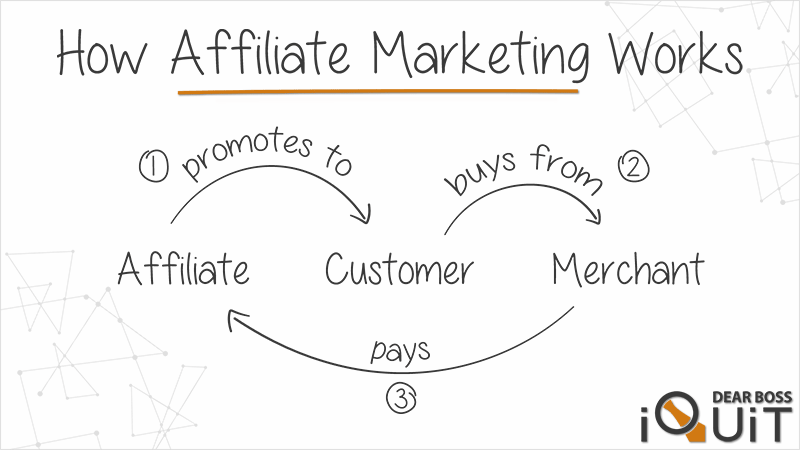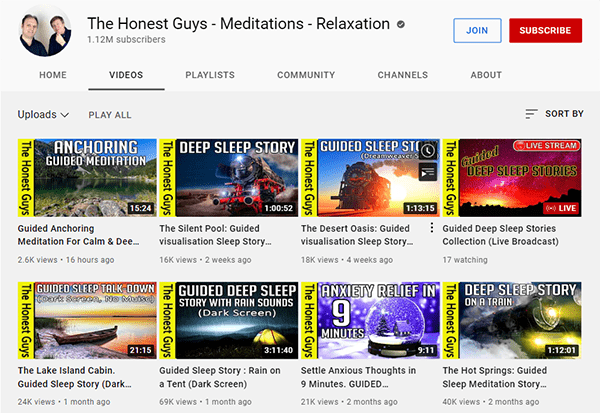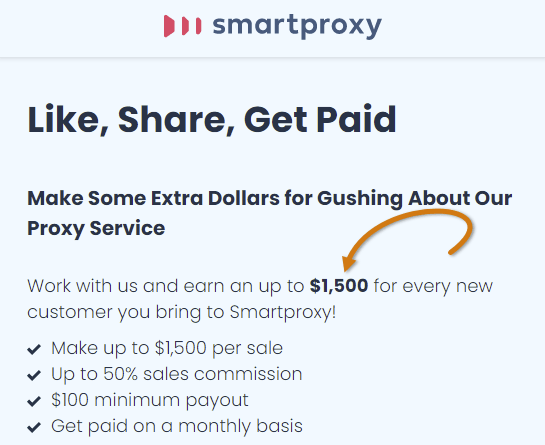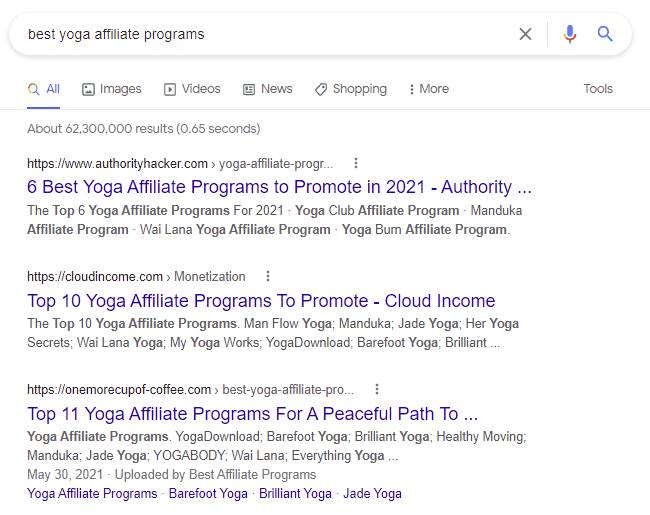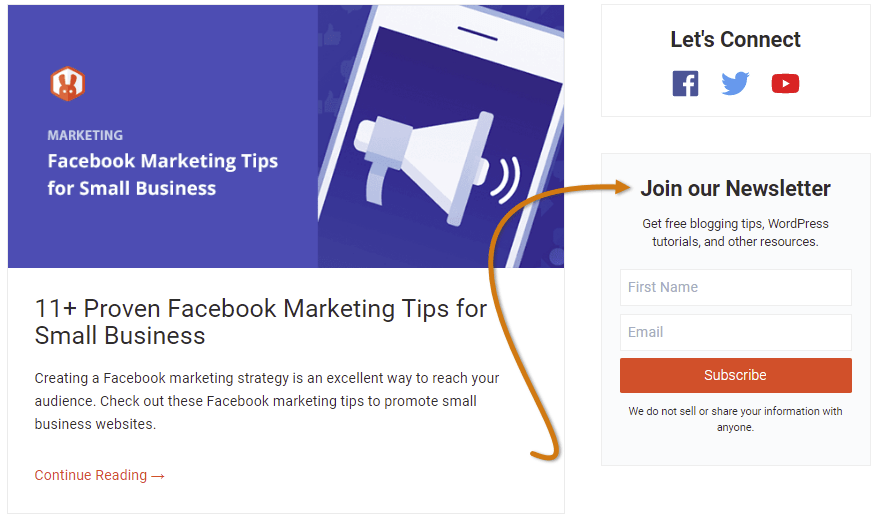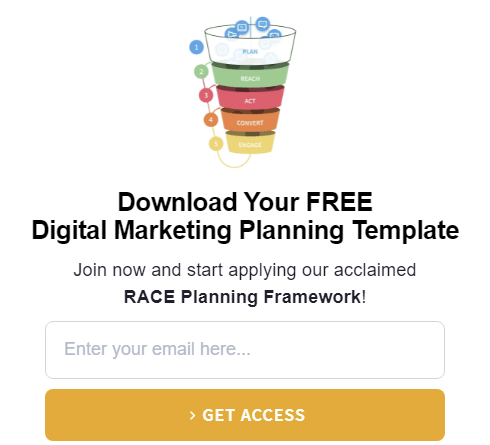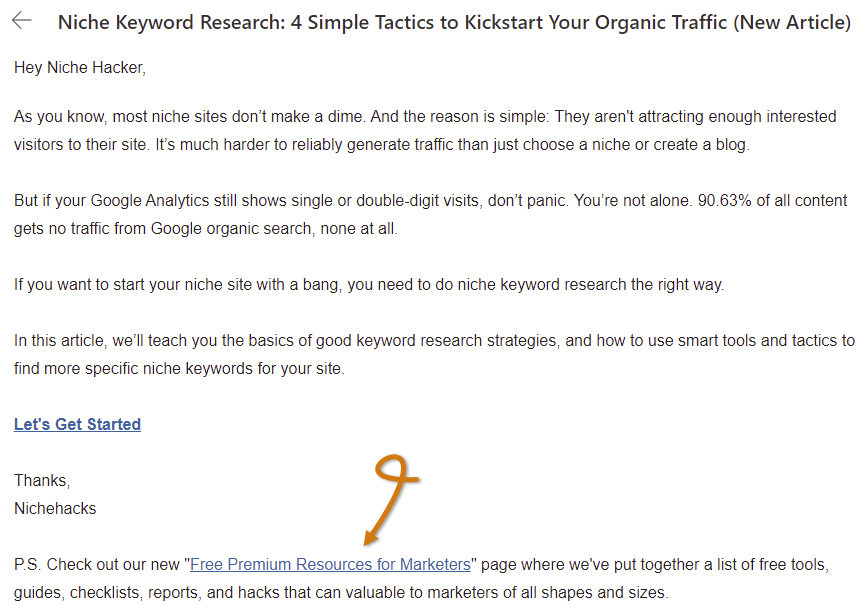Over the last few years, the popularity of the affiliate marketing industry has skyrocketed.
Frankly, that’s not surprising at all…
Who wouldn’t be interested in venturing into one of the best, simplest, and most cost-effective methods of building a sizeable income online without even having to develop, launch, maintain, support, or deliver a product/service of their own?
I know I would, and since you’re here, I can safely assume that you are as well.
If that’s indeed the case, you’re in the perfect place!
This step-by-step beginner’s guide is geared towards outlining the entire process of making money with affiliate marketing, from A to Z, even if you’re the least tech-savvy person in the world.
Without further ado, let’s get started by recapping what affiliate marketing is.
What Is Affiliate Marketing & How Does It Work?
Understanding exactly what affiliate marketing is and how it works is key to successfully leveraging it towards making money online.
Affiliate marketing comes into existence through the close synergy of 3 core parties:
- Merchant
- Customer
- Marketer
1. Merchant
An affiliate merchant (aka “advertiser”, “retailer”, or “vendor”) is any product seller that runs an affiliate program. Merchants can be as big as companies like Samsung and Apple, or as small as solopreneurs like Matt Diggity and John Crestani who sell high-quality affiliate courses.
Upon joining a merchant’s affiliate program, you’ll be given an affiliate link that’ll contain your unique affiliate ID.
The purpose of an affiliate link is twofold.
- It redirects whoever clicks it to the merchant’s online store
- It enables the merchant to track and attribute each affiliate sale to the marketer who referred it
2. Customer
Having an ample customer base is the vital ingredient that helps every single business on the planet maintain a steady income flow.
This is one of the main reasons that the vast majority of contemporary businesses are happy to compensate anyone who helps them acquire more customers with generous commissions.
That’s exactly where you, the marketer, come in.
3. Marketer
Your job as an affiliate marketer is as straightforward as driving as many customers as possible to the online stores of the merchants you’re affiliated with.
Every time a customer makes a purchase from an affiliate merchant you referred them to, the merchant will pay you a commission.
Here’s an example of how merchants, consumers, and affiliate marketers synergize to shape affiliate marketing.
- You join Amazon’s affiliate program & get your hands on your unique affiliate link
- You start sharing your affiliate link online (social media, forums, blog, YouTube, etc)
- A person named John clicks your affiliate link and get’s redirected to Amazon’s online store
- Since John got to Amazon after clicking your affiliate link, Amazon credits the referral to you
- If John ends up making an online purchase from Amazon, you’ll get paid a commission
Having said all that, in very simple words, affiliate marketing is when a marketer earns commissions for referring paying customers to third-party online merchants they’re affiliated with.
If you lack a solid understanding of affiliate marketing’s mechanics, I suggest that you check out What Is Affiliate Marketing and How Does It Work?
How to Make Money With Affiliate Marketing
The process of making money with affiliate marketing can be broken down into 6 Simple Steps:
- Pick a Target Niche
- Build Online Assets
- Acquire Web Traffic
- Promote Affiliate Offers
- Leverage Email Marketing
- Invest in Quality Guidance
Let’s take a more in-depth look at each step individually.
1. Pick a Target Niche
The first step to making money with affiliate marketing is picking a target niche, that is, the main topic that your affiliate business is going to be focusing on.
There are millions of affiliate niches to choose from, including, but not limited to:
- Shoes
- Electronics
- Software
- Online Courses
- Makeup
- Gaming
- & many more
The affiliate niche you’re going to target is one of the key factors that could make or break almost all aspects of your journey to affiliate success.
Simply put, pursuing the wrong niche could inhibit your progress, crush your profit potential, diminish your ROI (Return On Investment), and consequently, significantly decrease the chances of reaching your financial goals.
As such, picking a niche for your affiliate business should be handled with extreme care by taking stock of the 3 Golden Rules right below.
Rule #1: Low to Modest Competition
Steer clear of niches that consist of too much well-established competition that could trample small affiliates with no authority like you, such as:
- Health, Fitness, & Weight Loss
- Personal Finance & Making Money
- Dating & Relationships
- Beauty & Fashion
- Personal Development
The less competitive a niche is, the easier you’ll break into it.
Rule #2: Modest to High Demand
On the other end of the spectrum, make sure that you avoid niches that come with very little consumer demand. That’s because the less the consumer demand within a niche, the smaller your profit potential will be.
For a niche to be considered “ideal” it should strike a pretty decent balance between low competition and high demand.
Rule #3: Passion
The last rule of choosing the right niche for your affiliate endeavors is going after one that’s geared towards a subject you’re interested in or, even better, passionate about.
Becoming a successful affiliate marketer involves a steep learning curve and immense amounts of work over a significant period of time so pursuing a topic you love will naturally help you maintain consistency in your efforts, do higher-quality work, stick with your affiliate endeavors even when the going gets tough, and make better and faster progress towards reaching your financial goals.
On the contrary, if you launch a business that’s geared towards a subject that couldn’t interest you less, you’re more likely than not to give up before you even make your first affiliate sale (or soon after).
2. Build Online Assets
Once you’ve zeroed in on your niche, you need to start building online assets.
An online asset is anything you can use to reach out and interact with your target audience over the internet, such as:
- Blog
- YouTube channel
- Instagram page
- Facebook group
- TikTok account
- etc
You can think of your online assets as “digital signposts” that’ll be directing people in your selected niche to the e-shops of the affiliate merchants you’re in cooperation with.
Typically, the more online assets you have, the higher the reach, credibility, trustworthiness, and authoritativeness of your affiliate business. Nonetheless, if you’re a complete beginner to affiliate marketing, I’d suggest that you take it slow and focus your initial efforts on mastering just one at a time, or else you might end up getting yourself overworked and overwhelmed.
The two online assets that are being leveraged by the vast majority of affiliate marketers due to their very high efficiency for promoting affiliate offers are YouTube channels and blogs.
Launching a YouTube channel is completely free and extremely straightforward. All you have to do is:
- Create a Google account
- Head over to YouTube
- Sign in using your Google account
- Click your profile picture (top right corner)
- Select “Create a channel”
Starting an affiliate marketing blog is somewhat more pricey and effortful but fortunately, thanks to the huge advancements in website-building technology, it’s not as complicated and costly as it used to be a few years ago.
As a matter of fact, there are dozens of platforms (e.g. WordPress, Medium, Weebly, and Blogger) that can be leveraged towards building a fully-functional affiliate website for free in mere minutes even if you’re the least tech-savvy person in the world.
The video right below lays down the process of launching a WordPress-based affiliate blog in just 30 seconds without spending a single dime!
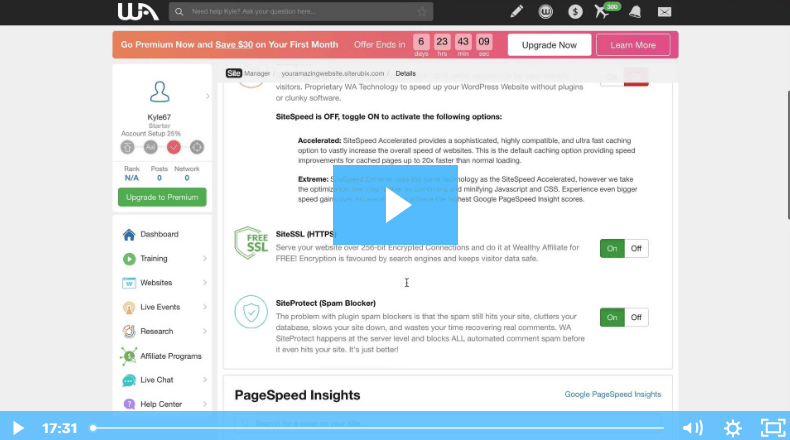
3. Acquire Web Traffic
After your online asset(s) are in place, it’s time to start acquiring web traffic.
Web traffic is the total volume of people who land on your online assets (e.g. Instagram followers, blog visitors, YouTube viewers, etc), a percentage of whom might end up purchasing one or more of the affiliate offers you promote.
The amount of web traffic you drive to your online assets is almost exclusively correlated with the size of your affiliate income. To put it in simpler words, the more web traffic you get, the more affiliate sales you’ll be making.
As such, web traffic can be easily regarded as the “bread and butter” of your success as an affiliate marketer.
Web traffic can be split into 2 main categories.
- Free Traffic
- Paid Traffic
Let’s take a closer look.
Free Traffic
Free traffic refers to any kind of traffic generated without spending money on paid advertising.
The two free traffic generation methods that have a track record of being the most effective for promoting affiliate offers are:
- Content Marketing
- & Search Engine Optimization (SEO)
Content marketing is the process of publishing niche-relevant content on your online assets, such as:
- Tutorials
- How-to guides
- Product reviews
- Roundups
- Case studies
- Images
- Live webinars
- & more
For example, The Honest Guys’ YouTube channel that’s geared towards the meditation niche revolves around creating content in the form of YouTube videos that cover meditation tips, breathing techniques, and guided sessions.
Likewise, the Instagram page “Best of Vegan” that targets people in the vegan niche focuses on publishing posts about vegan-related subjects like vegan recipes and cooking tips for vegans.
If you decide to scale your affiliate business using content marketing, you’ll need to emulate a pretty much identical approach and tailor it based on your target niche and the workings of the online asset(s) you operate.
The more content you publish throughout your online assets, the higher your chances of reaching a wider and more diverse spectrum of potential buyers. On top of that, producing highly valuable content is going to convince your target audience that you’re a credible, authoritative, and trustworthy figure who can answer their questions, address their concerns, and help them find solutions to their problems.
This will in turn increase your conversion rates, that is, the percentage of users who purchase the affiliate offers you promote.
Search Engine Optimization (SEO) is a set of practices designed to “convince” search engines like Google, Bing, and Yahoo to place a blog at higher positions of their results pages when specific keywords are queried. The higher a blog gets displayed on a search engine’s results pages (SERPs) the more free traffic it receives.
To give you an example, as you can see in the image below, the first position of Google’s search results for the keyword “Best Gaming Keyboards” is occupied by PCGamer, the second by RTINGS, and the third by TechRadar.
This means that PCGamer performs better SEO and receives more free traffic than RTINGS and TechRadar for the keyword “best gaming keyboards”.
Paid Traffic
Paid traffic refers to web traffic generated via promotions placed on third-party digital advertising platforms in exchange for actual money.
Paid promotions can be broken down into multiple different categories, including, but not limited to:
- Display Ads: Banners, texts, or images placed on third-party websites
- Paid Search Ads: Displayed on search engines like Google & Yahoo
- Social Media Ads: Served on social media platforms like Facebook & Instagram
- Sponsored Ads: Content created and distributed by influencers in your niche
- Native Ads: Promotions that resemble the style of the platform on which they appear
A few of the most popular and commonly used paid traffic acquisition channels are Google, Facebook, Instagram, Pinterest, Twitter, and TikTok, among many others.
Paid traffic can be paid either per ad click (PPC – Pay Per Click) or per 1000 ad impressions (PPM – Pay Per Mille).
Free vs Paid Traffic
The main advantage of leveraging free traffic is being able to get your affiliate offers in front of potential buyers without spending any money.
However, gathering the required amount of free traffic to start making affiliate sales involves a steep learning curve, immense amounts of upfront work, tons of trial & error, a lot of time, and massive patience.
On the other hand, paid traffic allows you to get eyes on the affiliate offers you promote instantaneously and hassle-free, practically the exact moment you pay your chosen ad provider and launch your ad campaigns.
The downside of paid ads is that you run the risk of losing all the money you invested in them for nothing as there’s no guarantee that the traffic you pay for will generate any actual affiliate sales, something that’s quite common among beginners to affiliate marketing.
In simpler words, free traffic requires no financial commitment but involves tons of work over a large period of time and yields slow results while paid traffic bears fast results but involves a monetary investment that might not pay off at all.
If you decide to go down the free traffic path, I strongly suggest that you consider signing up for a high-quality free traffic affiliate marketing course like Wealthy Affiliate or The Affiliate Lab.
If you’d rather utilize paid traffic, you might want to check out two of the best affiliate courses on running paid ads, Commission Hero and Super Affiliate System Pro.
4. Promote Affiliate Offers
The next step to making money online with affiliate marketing is monetizing the web traffic that flows into your online assets by promoting niche-relevant affiliate offers.
Affiliate offers can be divided into two main categories:
- High-Paying, Low-Volume
- Low-Paying, High-Volume
High-paying, low-volume refers to affiliate offers that grant big commissions per sale but have a limited pool of potential buyers. An example would be a pricey business software like SmartProxy that pays up to $1,500 for every new business referral.
Low-paying, high-volume are the exact opposite; they yield low commissions but possess a massive base of possible customers. An example of such an offer would be an affordable retail product like a pair of shoes, a PS5 game, or a baby car seat, none of which acquires payouts higher than $10 per sale.
The type of offers you’ll be endorsing as an affiliate depends mostly on your niche and level of expertise.
For instance, if your target audience consists of businesses, going high-paying, low-volume might make the most sense whereas if it encompasses retail consumers, the best course of action would be to focus on low-paying, high-volume.
Furthermore, it’s worth noting that high-paying, low-volume offers tend to attract way too many well-established, highly-skilled marketers that could crush small affiliates with no authority like you. As such, if you’re a beginner to affiliate marketing, you’d be much better off sticking with the less competitive offers that yield lower payouts but have greater demand.
The most straightforward method of locating affiliate offers is by browsing through affiliate networks like:
- ClickBank
- ShareASale
- JVZoo
- Commission Junction
- & FlexOffers
Alternatively, you could head over to Google and search for “Best [your niche] affiliate programs” as depicted in the image below.
If you’re trying to locate the affiliate program of a specific merchant, you can either Google “[merchant’s name] affiliate program” or head over to the merchant’s official website, scroll down to its footer, and look for a link named “Become an Affiliate”, “Affiliate Program”, “Partners”, or something of a similar nature.
If you’re after promoting a specific product/service that doesn’t seem to have an affiliate program, you can reach out to its merchant and ask if they’d be willing to build an affiliate relationship with you.
Always keep in mind that the affiliate offers you promote MUST be relevant to your target niche. Promoting any kind of commodity that’s irrelevant or useless to your target audience will not only crush your conversion rates but also destroy the credibility, reputation, and trustworthiness of your entire business.
For instance, if you start an affiliate blog that revolves around yoga, you should promote nothing but yoga-related offers, such as:
- Gear
- Guides
- Books
- Courses
- Retreats
- etc
Furthermore, make sure that every single affiliate offer you endorse is geared towards delivering value and genuinely benefiting your audience, either by helping them solve a problem, reach a goal, save time and effort, or just have fun.
Last but not least, it’s strongly suggested that you promote ONLY products that have a decent online reputation as they’ll almost certainly be converting light years better and faster than products with a lot of negative or no reputation at all.
5. Leverage Email Marketing
Despite its relatively old origins that date back to 1978, email marketing is still considered the Holy Grail of marketing, generating an ROI (Return on Investment) hundreds of times larger than any other form of marketing, digital or otherwise.
That’s because, unlike most other marketing channels that revolve around acquiring new customers, email marketing enables you to conveniently reach out, interact, and engage with your existing audience directly on their personal or business inbox, anytime and for any given matter, such as:
- industry news & updates
- new content notifications
- answers to common concerns
- product discounts & special offers
- solutions to burning problems
- & even direct affiliate promotions
Maintaining such a consistent stream of open communication with your target audience will nurture and strengthen your relationship with them, boost your trustworthiness, credibility, and brand awareness, increase your repeat web traffic, and ultimately, skyrocket your affiliate sales.
The process of utilizing email marketing consists of 5 steps.
Step #1: Sign Up for an Email Marketing Service
Email marketing services grant access to all the required resources to launch, maintain, and optimize email marketing campaigns; from landing pages builders and lead capturing popups to automated email sequences, mass email blasts, A/B testing features, and more.
Some of the best email marketing service providers out there include, but aren’t limited to:
- ConvertKit
- MailChimp
- SendinBlue
- MailerLite
- & GetResponse
Most email marketing platforms are rather pricey, except for MailerLite that’s completely free to join and utilize.
In fact, I’ve personally leveraged MailerLite towards launching multiple email marketing campaigns without spending a single cent.
Step #2: Build a Lead Capture Form
The purpose of lead capture forms is to collect the contact info (name & email address) of the people who land on your online assets. Lead capture forms can be placed anywhere from squeeze pages, popups, and sidebars to hello bars, footer widgets, and in-content sections.
Here’s an example of a lead capture form located on the sidebar of the RafflePress blog.
Step #3: Create a Lead Magnet
A lead magnet is a valuable resource (e.g. ebook, webinar, template, 1-on-1 consultation, discount, case study, etc) that you’ll be giving away to anyone who submits their contact info to your lead capture form.
For instance, as you can see in the image below, the lead magnet for signing up for Sportique’s newsletter is a 10% discount.
Another example of a lead magnet is the free digital marketing planning template offered by SmartInsights.
Step #4: Set Up an Automated Email Welcome Sequence
An automated email welcome sequence is a series of emails set to start dripping out at predetermined intervals the exact moment someone subscribes to your email list.
Your welcome sequence should be geared towards delivering high value to your audience by sharing info about yourself and your journey, explaining how and why your business is better than its competitors, distributing helpful and relevant pieces of content, addressing common questions and concerns related to your niche, and much more.
Here’s how a typical welcome email series looks like:
- Upon subscription: Welcome email
- Day #2: A few words about your business
- Day #3: Introduce yourself and tell your story
- Day #4: Outline the benefits of your business
- Day #6: Set expectations straight
- Day #8: Share your top pieces of content
- Day #11: Provide answers to FAQ
- Day #14: Promote a relevant affiliate offer
Step #5: Promote Your Affiliate Offers
The last step to leveraging email marketing towards making money online as an affiliate is launching email campaigns promoting your affiliate offers.
A rule of thumb for boosting the effectiveness of your promotional email campaigns is to ensure that they don’t resemble sales-driven ads, but rather illustrate the value of the products you endorse in a thoughtful and organic way optimally via delivering high-quality content, customer success stories, testimonials, industry updates, special offers, etc.
This is exactly what Nichehacks do in their promotional emails; they focus on educating their readers about subjects that might interest them (e.g. niche keyword research) while placing a subtle link to a resource page that contains all their affiliate promotions at the end of each email after their message has been fully conveyed (example below).
6. Invest in Quality Guidance
Many so-called affiliate “experts” support that since there’s an endless amount of free info about building and growing an affiliate business from scratch all over the internet, aspiring affiliate marketers can reach success without spending money on dedicated affiliate education programs.
Such statements couldn’t be further from reality.
The vast majority of free material on affiliate marketing is inaccurate and ineffective distributed by clueless fraudsters. Failing to distinguish between the valuable and the worthless could set you back months, if not years, utilizing crappy techniques that not only hinder your progress but also take you further away from your financial goals.
Not so surprisingly, affiliate marketing statistics reveal that the #1 reason holding beginners to affiliate marketing back from successfully scaling their business and revenue is lack of proper guidance.
On the other hand, having access to a step-by-step, tried-and-tested blueprint to affiliate success can short-circuit your learning curve, minimize trial and error, speed up your progress, maximize your revenue, and significantly increase the chances of achieving your monetary objectives.
Having said that, if you’re smart enough to understand that investing in high-quality guidance is in your best interest, make sure to check out the Best Affiliate Marketing Courses that have helped hundreds of people go from zero to building a sizeable affiliate income online or sign up for this FREE Crash Course that walks you through the process of launching your first affiliate website in less than 1 hour without spending a single dime.
Conclusion
That’s pretty much the entire step-by-step process of making money online with affiliate marketing as a beginner.
It might seem rather simple but it’s no walk in the park. On the contrary, it involves a steep learning curve, immense amounts of work, tons of trial & error, and massive patience over a significant timeframe that could span several years.
Nevertheless, I guarantee that if you implement all the info, tips, and suggestions I laid down throughout this guide, you’ll be well on your way not just to making your first affiliate sale in no time but also to building a thriving, long-standing affiliate marketing business.
If you have any questions or require further help getting started, I encourage you to leave a comment right below or contact me right here and I’ll do my best to get back to you as soon as possible.
Best of luck in your affiliate marketing endeavors!
Harry, Founder & Editor at dearboss-iquit.com


